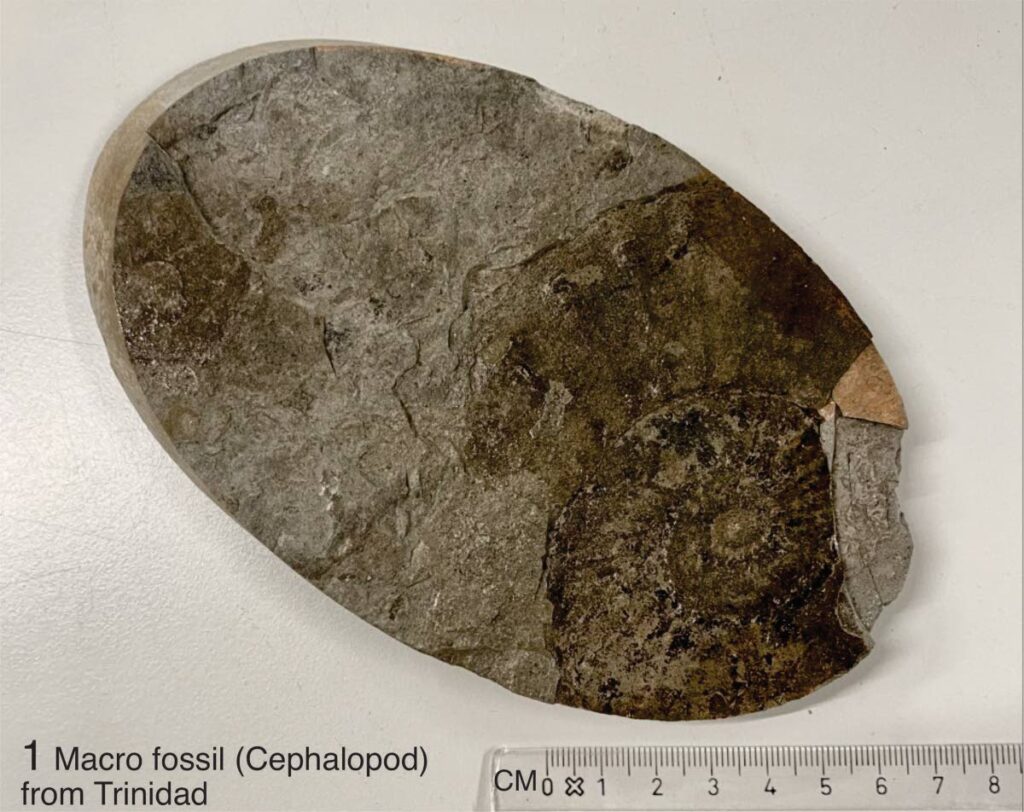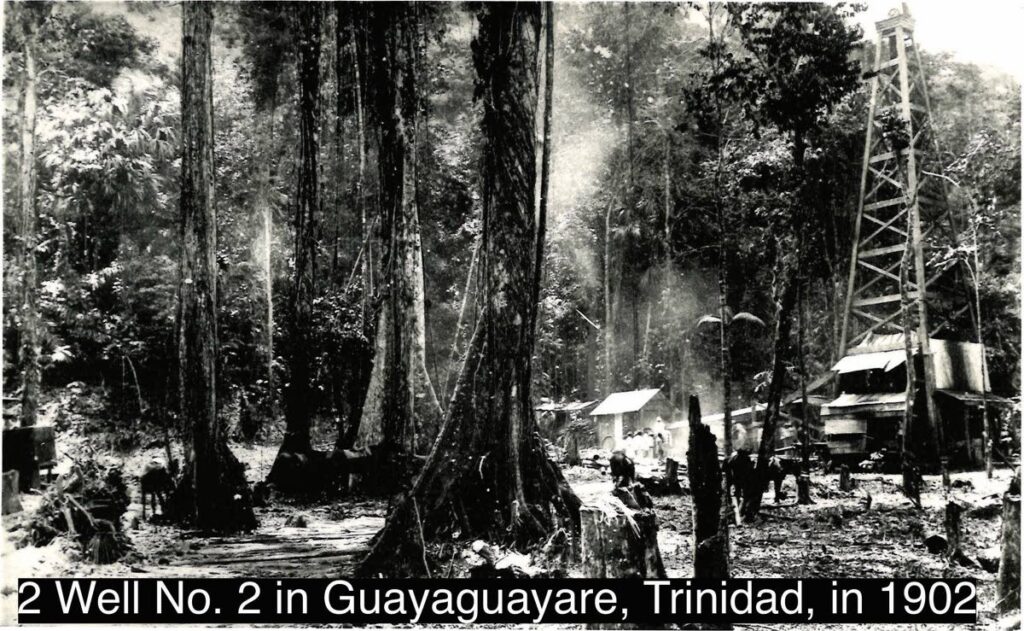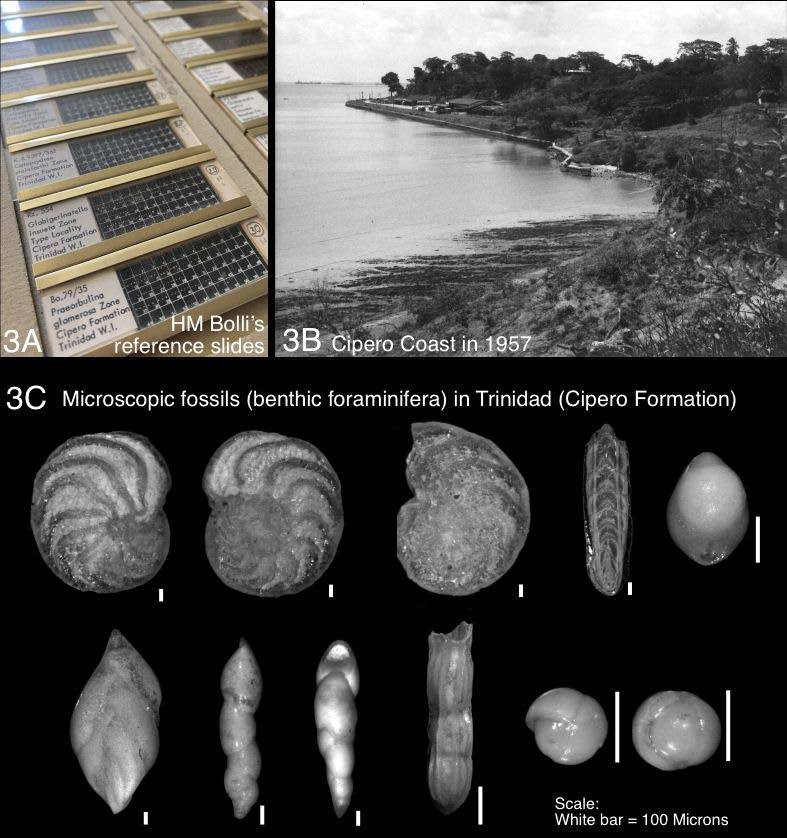Sadie Samsoondar – Trini fossil specialist in Switzerland

GEOLOGICAL SOCIETY
Dark corridors, narrow winding staircases, and hidden Trinidad treasures lay within the Natural History Museum in Basel (NMB), Switzerland. I am a Trini micropalaeontologist (I study microscopic fossils) researching the Trinidad archives at the NMB.
Since the early 1900s, Swiss (and other international) micropalaeontologists were drawn to Trinidad for the exploration of oil.
Dr Hans Kugler (1893-1986), a Swiss micropalaeontologist and geologist, gained the honoured title as "father of Trinidad’s geology" after working in Trinidad for more than 45 years.
In 1959, Hans Kugler retired back to Basel after which he became the honorary head of department at the NMB.
At the NMB, he preserved a great amount of Trinidad’s history in the form of maps, documents, literature, photos, and samples.
Samples range from rocks, microscopic and macro (can be seen with the naked eye) fossils, cores from oil wells, and thin sections (thin slices of rocks that are examined under the microscope).
I am the first Trinidadian researcher to re-establish a connection with the NMB after more than 25 years of dormancy. I am providing expert insight into the Trinidad archives.
Some of my interesting finds include some of the oldest macro fossils found in Trinidad, historical photos of early oil wells, and famous microscopic fossils.
Photos and material presented here were sourced from the micropalaeontological collections at the NMB1.

Photo 1 shows a fossilised cephalopod found in northern Trinidad. Cephalopods are shelled marine organisms that lived in the world’s oceans between 450 to 66 million years ago.
Interestingly, Trinidad’s Northern Range is of different origin than central and south Trinidad. Around (at least) 22 million years ago, the movement of the Earth’s crust resulted in the translation of the Northern Range land mass from the Venezuela area.
This land mass was subsequently welled onto the land mass of the central and southern Trinidad. As such, fossils found within the Northern Range may not always be found in central and south Trinidad, and vice versa.
This also explains why oil, found abundantly in south Trinidad, is not found in northern Trinidad.
Photo 2 shows oil well No 2 drilled in Guayaguayare, south Trinidad, in December 1902.
The well was completed to 1007 feet in March 1903 and had several oil shows.
In 1857, the first documented oil well was drilled in La Brea by Merrimac Company. The well struck oil and was drilled to approximately 280 ft. However, due to low funds it was classified as being unsuccessful.

Kugler Archives at the NMB reported in 1797 the first occurrence of hydrocarbons in Trinidad by Sir Ralph Abercrombey: a gas eruption with bitumen off the coast of Mayaro, south Trinidad.
Trinidad plays an outstanding role in the development of micropalaeontology.
Micropalaeontology occupies a central role in modern earth sciences and in the petroleum industry. Microfossils help us date the rocks within which they are found and tell us what the earth was like when the organisms were living.
In the 1960s, a small group of micropalaeontologists working at Trinidad Leaseholds Limited (later Texaco Trinidad), Trinidad, derived a reliable standard for dating and correlating Cretaceous and Tertiary sediments of Trinidad. These micropalaeontologists were HH Renz, RM Stainforth, B Caudri, P Brönnimann, HM Bolli, WH Blow, JP Beckmann and JB Saunders, who worked under the guidance of Hans Kugler.
These works in Trinidad subsequently stimulated similar works in other parts of the world.
Photo 3A shows reference slides (7.5 cm x 2.5 cm) for plankton stratigraphy prepared by HM Bolli.
These slides provide a global standard used for dating sedimentary rocks based on their microfossil content. Some of HM Bolli´s microfossils were collected along the "Cipero Coast" which is the geological name given to "duck pond" near Kings Wharf in San Fernando, south Trinidad.
Photo 3B shows the Cipero Coast in 1957. This coast is a type section, ie it is the first place (globally) that specific fossils were found and documented.
This coast is an international type section and should be protected for its global micropalaeontologic significance.
Photo 3C shows microscopic fossils (less than one millimetre) which I prepared for my PhD thesis, research papers and co-authored e-book.
These fossils belong to the same rock layer (the Cipero Formation) as those collected by HM Bolli in Photo 3A1.
The fossils belong to a group called foraminifera which are single-celled, calcareous shelled, marine organisms. This group existed since 550 million years ago.
Fossils in 3C are approximately 16 million years old.

Fossils in 3C once lived in the ocean that was over present-day southern Trinidad 16 million years ago.
The ocean was more than 2000 metres deep. Sedimentary rocks deposited here later became a major producing hydrocarbon reservoir in Trinidad.
For more scientific details about my research on Trinidad microscopic fossils, see my e-book Early Neogene Stratigraphy and Palaeoceanography of Trinidad, West Indies: A Fresh Perspective4.
My research at the museum shows the importance of specialist investigations into historic documents. Connecting primary literature with the objects stored at institutions restores its usefulness for future scientific investigation.
The Trinidad archives at the NMB also show the importance of preserving our history. Trinidad’s history is rich and full of scientific accomplishments. Learning about our past is key to achieving scientific progress in the future.
Hans Kugler's legacy at the NMB displays synergy between openly published academic research and its application into the oil and gas industry. Industrial micropalaeontology greatly declined in Trinidad and other parts of the world since the 1970s.
I am proud to be a Trinidadian woman in micropalaeontology. It is my hope that local universities and industries financially support more scientific research that will benefit Trinidad it many ways.
References
1 Micropalaeontologic Collections at the NMB. The micropaleontological collections at the NMB (unibas.ch)
2 Hans Kugler Stratigraphic Collection at the NMB.
3 Trinidad Photo Archive at the NMB
4 Samsoondar, Sadie, Wilson, Brent, Farfan, Philip, 2020. Neogene Stratigraphy and Oceanography of Trinidad – A Fresh Perspective. Nova Science Publishers (Hauppauge, New York, United States).
Sadie Samsoondar is a micropalaeontologist specialised in deep-water Miocene benthic foraminifera and the historical development of micropalaeontology in Trinidad. Her past research reconstructed models of ancient environments for south and central Trinidad during the Miocene. Regional inferences across the wider Caribbean area were also drawn. She is now a researcher at the Natural History Museum, Basel, Switzerland working on the project, Digitizing the Kugler Archive: Link to the collection.


Comments
"Sadie Samsoondar – Trini fossil specialist in Switzerland"